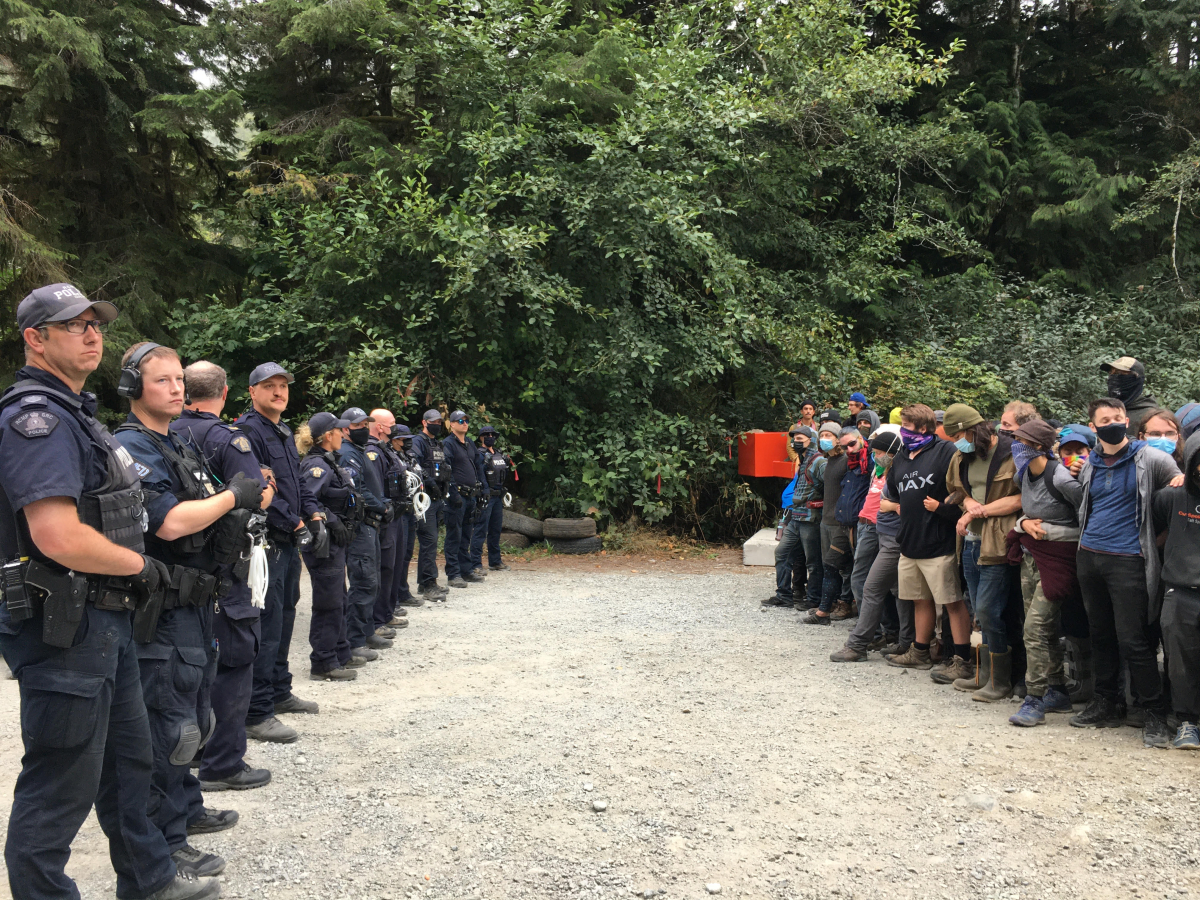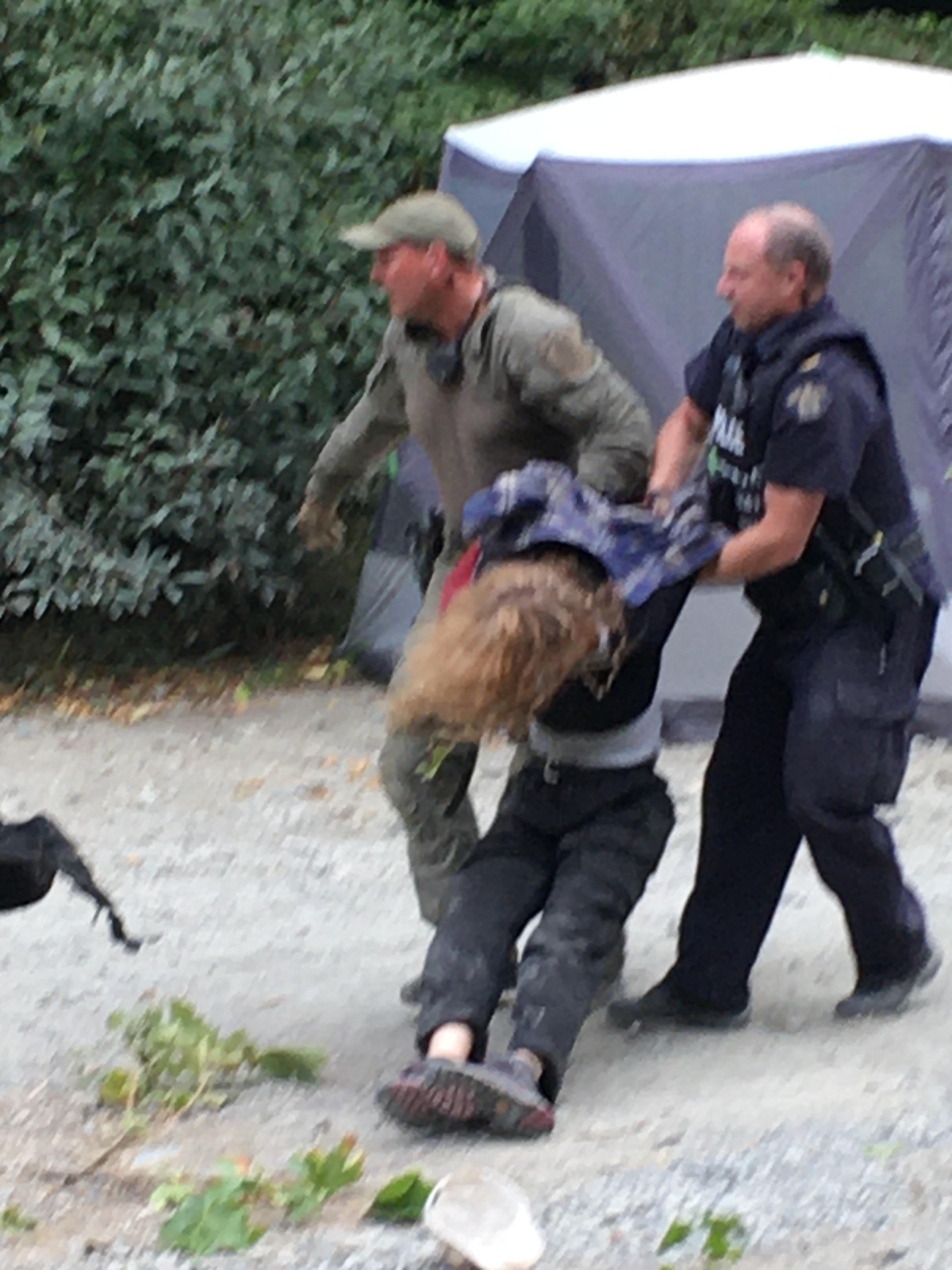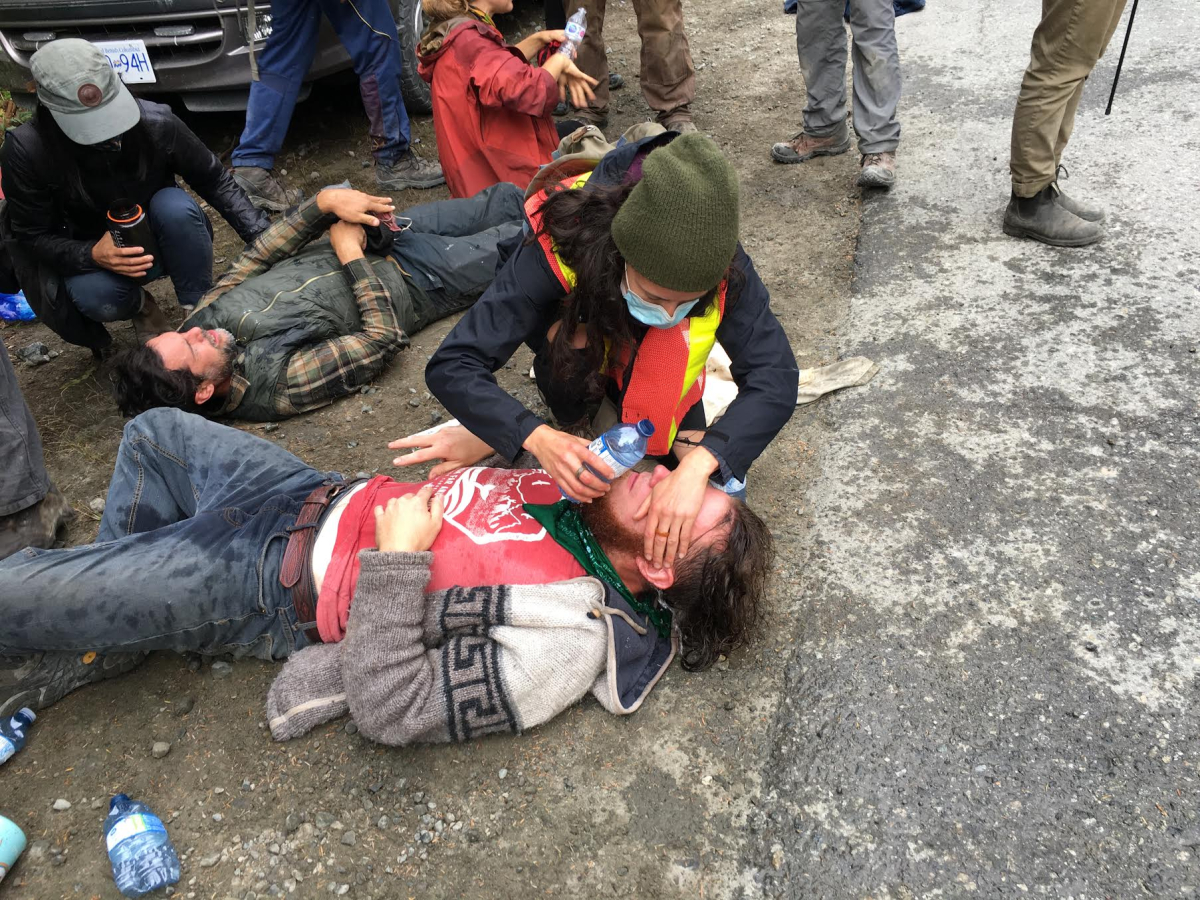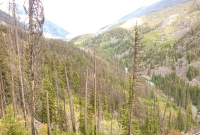Support strong Canadian climate journalism for 2025
Tall tree, deep water, strong wind, warm fire –
I can feel it in my body, I can feel it in my soul.
It is 6 a.m., just after dawn, and a crowd is already gathering at the Fairy Creek base camp, 50 feet from the main logging road into the old-growth forest. They are mostly young people, a mix of Indigenous and non-Indigenous. Kati George-Jim is one of the leaders, a member of the T'Sou-ke First Nation. Wearing a woven cedar hat, she speaks with authority, directing the group to form a tight group, arms linked, facing outward. There are a lot of directions about how to loosen up and spread out within the circle. Then approximately 70 "land defenders" begin the walk to the main gate.
In position, the group begins to sing in rounds: Tall trees, deep water… I can feel it in my soul.
Standing apart with other witnesses, hearing their voices, I can’t help but be moved. These young activists blocking the road in an act of non-violent civil disobedience are apparently the only defence for the thousand-year-old trees in the Fairy Creek Forest. Biologists call it an irreplaceable ecosystem, home to almost extinct green lichen, endangered owls, bears, and marbled murrelets. As an old-growth forest, it is also one of nature’s best ways to sequester carbon and offset climate change.

Suddenly an organizer in overalls leaps onto a cement block: “Who keeps us safe?” Enby calls out, and the crowd, clearly practised, calls back: “We keep us safe!”
“My heart is singing,” Enby calls to the group, “because at the end of the day… we... we are cuter than them!” There’s laughter in the group.
Again I study their faces. They are pretty cute — there’s no denying. But powerful, too. With traditional cedar hats, and many with rainbow scarves over mouths and noses (COVID precautions in the tight mass). I spot a man with his beard dyed blue, who goes by the name Ace, and Dianne Cronmiller, a clinical counsellor from Victoria. Directly facing me is Malika Bindra, a soft-spoken 21-year-old. She told me earlier that she’s studying at Quest College in Squamish to become an elementary school teacher. Inspired by the old-growth forests of Meares Island, she wants to teach children about the wilderness.
“My mother is worried about me,” she said. “And she doesn’t even really know how brutal it can get out here.”

As if on cue, the RCMP trucks pull up, a flurry of slammed doors. As at least 15 officers form a phalanx, facing the protesters, the singing is over and the mood feels adrenalin-soaked, militaristic. Officers tell me and other witnesses to move back. I move forward, citing the recent ruling from Judge Thompson (Teal Cedar Products v. Rainforest Flying Squad), which allows media access to witness protester actions and arrests, and prohibits "undue and unnecessary police interference with journalist functions." My voice is shaking.
“You,” a black-masked RCMP officer shouts at me. “Can’t you listen to orders?”
I ask for his badge number, and he refuses to provide it.
As I ask for the media liaison officer, the masked officer comes closer. “What’s with you?” he speaks with contempt. “With your camera and your little notepad.” I reach for my media accreditation papers but another officer, differently dressed in soft browns, tells me that if I continue to fail to comply I will be under arrest.

I’m marshalled across the road, feeling badly shaken. They mean to intimidate me, and they have. I locate the police media liaison officer, Gilles Deziel, standing suavely with his arms crossed. He gives me a calm smile, assures me that “our obligation is to remove people safely.”
But that’s the opposite of what happens next.
A special emergency response team (essentially a SWAT squad, Gilles Deziel explains) arrives. Working with remarkable speed these "Green Guys," as the activists call them, chain saw a stand of maple saplings, lay the trunks in the ditch to create a cord road, and drive their trucks through. In less than 10 minutes they’ve bypassed the protest group, gaining access to the road.
With this done, the RCMP circle the protesters and begin to push heavily against them. In their tight formation, the group can’t move. It’s clearly dangerous. Protesters call out reassurances (Who keeps us safe? We keep us safe!) while simultaneously shouting for the police to stop pushing. I see one protester, a blond woman, plucked from the group and thrown onto the dirt road. Another is dragged along the gravel, her arms zip-locked behind her back and yanked upwards by the officer. I turn to the police media liaison.
“Is that safe removal?” I ask.
“No comment,” he responds.
It isn’t just the protesters at risk. In the melee, an RCMP officer falls backward into the ditch, landing on his back. He needs to be helped up by fellow officers. Then officers produce red cans of pepper spray, aiming directly at the clustered protesters. The protesters scream as it hits. Eyes watering, clutching their throats, they begin staggering across the road to safety. It’s an unbelievable display of force and violence. Friends rush for water. Medics gather.
A woman with pink hair is doubled over near me, eyes streaming. She gestures to the red spot on her throat where an officer jammed his elbow into her larynx. Another woman, camp name Arbutus, tells me she was strangled by an officer. A third woman is helped into a van by friends, weeping violently, her piercing ripped from her lip.
I locate Malika Bindra sitting on the side of the road. She gives me a shy smile as I ask if I can sit with her. I’m thinking about how she told me she wants to take children into the wilderness. Be a teacher. “What was it like for you?” I ask.
“My mask fell off, and I have asthma,” she says simply. “I couldn’t breathe.”
I ask about her worried mother — what would she say to all this. Malika nods, then answers:
My mother always said to me, as a person of colour, just do what they (the RCMP) say. But I can’t. Not anymore. If I do, the forest will be cut down.”




Shaena Lambert is reporting on Fairy Creek for Canada's National Observer. She is the award-winning author of the novels Petra and Radiance and the short story collections Oh, My Darling and The Falling Woman.






Comments
The police have been getting more and more violent with the protestors. The only way I can report them is to report them to the heads of police where they will keep my name and contact information for ever. A lot of the police are also wearing the thin blue line, which their organization has said they should not be wearing. We need a body that oversees the RCMP it seems, with all the sexism etc. that is going on in their ranks and how violently they treat people they think are 'the enemy' from non violent protestors, to black, indigenous, and other coloured people being stopped for carding either walking or driving. Things often then escalate, and the police lie about what they did unless there is video of them doing what they did.
When we did civil disobedience in the 60's and 70's, we linked arms to make it difficult for the police to extract us from the crowd - same tactic here. But we knew we were 'breaking the law' and we expected that some of us would get hurt when the police did what they were paid for - enforce the law. If you go into the woods to deliberately break the law - contempt of court in this case of breaking injunctions - you can expect to get hurt when the police ask you to move on and you link arms and say 'Hell no, I won't go' or the modern equivalent. Moral authority has its price. Civil disobedience is a privilege tolerated by very few countries in the world., from Afghanistan to Zambia and back again. The purpose of protests is to get headlines to change the laws - the targets should be politicians, not the guys who make it possible for us to have a nice life by enforcing the [other] laws we agree with.
Alan, I did non-violent civil disobedience in the 60's and 70's too. I was arrested twice, even spent a weekend in jail, and the police were never violent in the ways I have witnessed at Fairy Creek. Then they seemed to understand that it was the action or inaction of politicians and governments - and the destructive practices of corporate entities those governments allowed - that we were protesting. That is what young people at Fairy Creek are protesting today. They are standing up for the future of ecosystems that are critical to our lives and life on earth. In this case, as the courts have just re-confirmed, it is the police who are breaching the boundaries of the court injunction and visiting unnecessary and increasing violence on those who are protesting the destruction of our remaining Old Growth forests. And those RCMP officers must be held to account.
The completely disportionate response from the RCMP absolutely should be targeted....along with their corporate and political enablers! Read BC Supreme Court Justice Thompson's rulings. This is NOT a police force giving us a nice life, it is a police force making it possible for rapacious resource extractors to make ever more obscene amounts of money.
Sorry, I did my share of protesting, and I always kept a healthy respect for the civility of the RCMP, even if there were the odd bad apple. However, having been there and seeing what has been happening, adding to that that Justice Thompson has pointed out that the RCMP's abuse exclusion zones and its barring of the press and observers were "unlawful". This is no longer the same RCMP. Their commanding officers, in particular Sargeant Manseau should be unceremoniously booted off the force, and the so-called "tactical unit" should be disbanded and its members processed for common assault charges. These are not "professionals", these are common hooligans in uniform. As far as I am concerned the RCMP should be de-funded and booted out of BC and replaced with a provincial force accountable to British Columbian taxpayers, not the government and corporations,
Thanks for the thoughtful reporting.
Imagine a time when the police would protect the people and the planet, instead of doing the bidding for crooked, lying, shameless politicians like "Talk and Log" Chainsaw Horgan and the clear-cut companies destroying these young peoples' futures by cutting the old-growth for short-term profits at the expense of the planet's future. Do these RCMP not have children that they want to see flourish in the future?
Bravo to all these young folks with so much moral fortitude, while the RCMP show so little. Is leadership in the RCMP so weak, that they can't see that these young people are on the high moral, economic and survival ground? The RCMP should be treating them with the undue respect they deserve.
Civil disobedience, under different names (often uncivil or even scurrilous) has existed for a long time. The Boston "Indians" practiced it while dumping tea into Boston Harbour.
Police and their predecessors were always in the employ of the rulers and there was no question that their function was to secure the wealth and property of those rulers. That is unquestionably still the purpose of the world's police forces - and all too often that is coupled with egregious violence against marginalised people. No doubt there is some residual confusion among the police about who pays their salaries and to whom they owe allegience.
In democracies, there is still this fiction that the police are "serving and protecting" the public. In fact it IS the public, the taxpayers, who are paying the police salaries, while we all know that the plutocrats, who routinely evade paying taxes, who are the principal beneficiaries of police services, of the judgements of the justice system.
Predatory capitalism (in democracies) now owns and controls police forces, and to a large extent it also owns and controls the justice system - because it can afford to fight in the courts endlessly to achieve its impunity and its objectives. On top of which predatory capitalism also owns and controls the democratic political systems - turning politicians, police and the judiciary into tools to enforce the grip of the plutocrats, the unregulated and out of control extractive and oppressive corporations whose primary goal is to strip from the earth whatever wealth they can, and to strip from the "lower orders,' or "castes" any power or agency over their own lives, any ability to achieve economic independence from corporate rule.
In the undemocratic states, the naked economic oppression and corruption does not bother with phrases like "Serve and Protect". Everyone knows the police and the military have only one function - protect the rulers, protect the plutocrats.
The distance between democracy and plutocratic tyranny narrows with every year. Soon the gap will be so small, not a sliver of light will get through.
Very nicely reasoned but you still blame the tool (RCMP) for the wielder's crimes (politicians in the thrall of predatory capitalism). When someone stole equipment from our sport club, the RCMP were great. They caught the thieves and recaptured most of the stolen goods. So let's not throw the baby out with the bath water.
I agree with an earlier comment about disbanding so-called tactical squads that are purposely geared up for brutality. I grew up in a country where the bobbies didn't carry guns: ever. But those truncheons really hurt!
Clearly illegal and cowardly actions by the "police" exposed thanks to Shaena Lambert and the National
Correction : Shaena Lambert and the National Observer.
I wonder how the RCMP would have responded if it was their kids linking arms. Such militaristic, crude and brutish behaviour is absolutely stunning….where does the license for this kind of behaviour come from? Something is seriously broken when police, who ostensibly keep the peace, are allowed to assume the role of corporate thugs just like the strike-breakers of years ago. Stay the course National Observer.
This kind of comment is hysteria. Equating the RCMP to the Pinkerton's who shot strike breakers and drove trucks through picket lines is just ridiculous and not justified.
Unfortunately, with much of today's standards of policing having changed over the last decades to a more militaristic 'commando' style, the comment is not an hysterical and unjustified response.
This is how the Canadian government and especially the NDP pseudo Social Democrat plans to fight climate change
Nothing ever changes regardless of who is power. They are all in the bag of big interests and that will not change